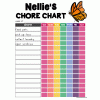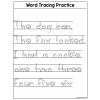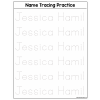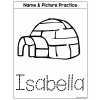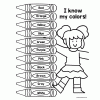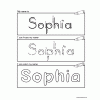Once kids have worked on proper number formation they can practice numbers by tracing them. The more they repeat each number, the easier it becomes muscle memory – and writing gets easier.
Printable Numbers Tracing Practice Worksheet
This worksheet is bare-bones for those who just want simple writing practice that covers numbers 1-20. The fonts are fully customizable, meaning you can swap them out to fit any learning style.
The Dotted Arrows Guided font is good for kids who still need some reminders on how to form their numbers. For more experienced writers, the standard Dotted font works great. There’s also cursive font options, which italicise the numbers.
You can even change the font colour!
Why Practice Writing Numbers 1-20
From a developmental perspective, if your preschool or kindergarten age child can master writing numbers 0-9 then they’re already capable of forming any number. After all, each number is a combination of those digits!
Page 1 of this worksheet covers numbers 1-10, which you should focus on first as your child develops their number writing skills.
Numbers 11-20 are also important in early childhood education, though. By introducing them early on, your child will be familiar with the following concepts:
- Counting past 10.
- How numbers follow a pattern, and that pattern is repeated.
- The way two digit numbers are represented, including the order (first number stays the same, second one changes.)
- Generally getting them used to multi-digit numbers.
When Should Kids Write Numbers 1-20?
Most kids should be able to trace numbers by the time they reach preschool age. Around age 5, children are expected to recognize numbers up to 20, and they’ll be expected to write them independently around first grade.
For younger learners, starting early can give your child a head start when they enter preschool or kindergarten. The less time kids spend in math class working on number formation, the more opportunities they’ll have to develop other numeracy skills.
Older children who need some extra practice writing their numbers will also benefit from using tracing worksheets like this one. With a little extra help they’ll be well on their way to independent writing.
Help With Number Identification
While working on writing, you can also use this worksheet to help kids identify each number. Have them say it out loud with each repetition to help them remember.
For an extra challenge, quiz kids by having them point to different numbers that you call out.
Make a DIY Marker Board
It’s easy to modify this worksheet with a DIY to create a reusable numbers tracing practice board.
If you have access to a laminator, print off both sheets in the font and colour you like best. Then put the pages with the backs together and laminate them.
Of course, not everyone has that. Another option is to use a plastic page protector. It works better if you use cardstock to give the sheet some stability, but you could also slip a piece of cardboard between the printed pages.
Slide both sheets, again back to back, inside the sheet protector. Then use clear packing tape or glue to seal it shut.
You can use dry erase markers or washable markers, then just wipe and reuse!
